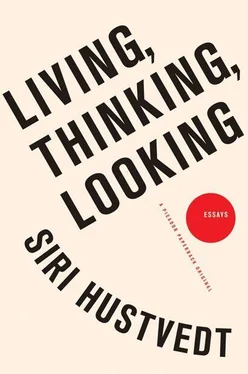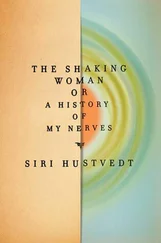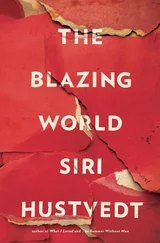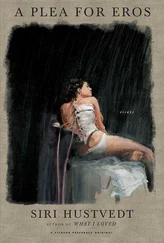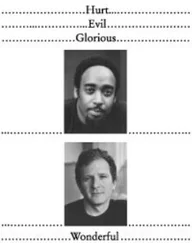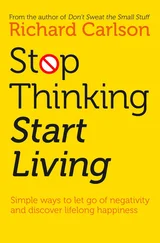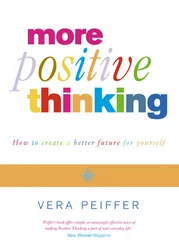Looking at a work of art engages this prereflective expectation of its value — of pleasure or disgust or boredom and their bodily concomitants. But this is usually instantaneous, and once one has stopped to look properly at a work of art, forms of reflective consciousness are also brought to bear. Indeed, almost all writing about art takes place at this level of the experience. We read about the historical period of the painting or sculpture or about the artist’s biography or about what x-rays reveal about its creation or perhaps a complex theoretical argument about the avant-garde or capitalism and the art market. If I know, for example, that Kosuth was interested in Ludwig Wittgenstein, especially the Tractatus Logico-Philosophicus, this information will affect how I “read” his chairs, just as knowing about Darger’s childhood changes his work. The Tractatus and years of boyhood spent in a mental institution are part of the intersubjective and linguistic fabric that clothes my perception as I think about what it is that I am actually seeing.
Despite significant advances in research on the visual areas of the brain, there is a lot of disagreement about how we actually see. It is known, for example, that there are as many as thirty areas in the brain dedicated to vision, that some of these areas or rather neuronal networks appear to be for specific functions: color, motion, depth perception, etc. Interestingly, there is also a part of the brain in the temporal lobe crucial to face recognition, the fusiform gyrus. Face recognition is a particular neurological event, and it too can be lost. But none of these discoveries constitutes a theory of vision. There are still many scientists and philosophers who cling to a computational model of perception. We are like computers with serial inputs and outputs, and our brains operate according to logical rules. In this view, seeing is largely passive. All we do is receive images from the world that are then represented like reflections in our brains. Another view, one I find far more compelling, is a phenomenological one. We are not computers, and we are not just brains. We have bodies that move in space and we have emotions and a vast unconscious, and our perceptions of people and things are active and creative. It has become increasingly clear that a large part of the dynamic patterns of neural connectivity in our brains is not predetermined genetically. They are not static but are shaped by our behavior and our motor-sensory and cognitive experiences. Learning changes the brain, and its plasticity continues throughout our lives.
Despite the scientific zeal to atomize experience, to break it down into comprehensible bits and pieces, this approach often results in a frozen view of reality. In recent years, parts of the scientific community have been influenced by the phenomenology of Husserl, and, more important, by Merleau-Ponty, to challenge a paralyzed, purely third-person view of perception. Neurobiologists such as Humberto Maturana and the late Francisco Varela, 18the cognitive scientists Shaun Gallagher 19and Claire Petitmengin, 20as well as philosophers such as Alva Noë 21and J. J. Gibson 22argue for an enactive theory of perception founded on our motor-sensory abilities and have embraced a whole-body-in-relation-to-its-environment understanding of vision. Although there is no unified front and there are many disagreements among them, my reading of these thinkers has led me to the position that viewers are not merely passive reflectors of the out-there, but embodied creative seers. Two researchers at the Max Planck Institute, Andreas Engel and Peter König, articulated the position well in a paper called “Paradigm Shifts in Neurobiology: Toward a New Theory of Perception”: “What neuroscience has to explain,” they write, “is not how brains act as world-mirroring devices, but how they serve as ‘vehicles of world-making.’” 23
Let us take a very simple example of active visual perception. One day last spring, I was walking down the street with my daughter, Sophie, in lower Manhattan. She had just moved into a new apartment a few blocks away, and we were shopping for household objects to put in her new place. The sun was shining. The sky was blue, and we walked along arm in arm. I felt like singing. I looked up, saw a sign and read: HAPPY ORTHODONTICS. I turned to Sophie and said, “Look, isn’t that the craziest name for an orthodontist’s office?” I pointed to the sign, but when I looked again, it said: KARPOV ORTHODONTICS. This simple error is illuminating. My misreading was subliminal, active, and creative. I projected my emotional state onto the text and proceeded to garble the letters. Similarly, it has been shown that clinically depressed people respond to pictures of neutral, unemotional faces in a far more negative way than people who are not depressed. Mood acts creatively on our perceptions.
The first time I saw Zurbarán’s Lemons, Oranges, and a Rose , which is in the Norton Simon Museum in Pasadena, California, I had a very strong reaction to the picture, and I stood in front of it for some time. It’s neither tiny nor huge: 60 by 107 cm. Its size did not overwhelm me, but I had no feeling of its being diminutive either. Its colors are vivid but muted against a dark background. I cannot track the initial unconscious milliseconds of my response to the picture, but I know the image hit me instantly and bodily, and had some person been there to measure the activation of my sympathetic nervous system that had sped up my heart rate and increased the sweat levels in my skin, he would have pronounced me in a state of heightened emotion and attention.
Why? How can four lemons on a silver saucer, oranges in a basket, a rose, and a teacup filled with water sitting on another silver saucer create such a physical charge? Naming the contents of the painting gets us nowhere; it is simply a banal recitation of ordinary things. And if I arranged these objects for you on a table, I could make a lovely still life. There would be a pleasant contrast of colors for the eye, but the visual experience would be very different. First of all, the real fruits, china cup, and flower would exist in three-dimensional space and have a backside that could be explored. Part of your perception would be that you could, if you dared ruin my construction, pick up a lemon or an orange and eat it. I could declare it my artwork, and it would be one. But you would never see the objects in my piece as this work by Zurbarán sees them. They appear to be in hyperfocus, to be more defined, more perfectly clear than things in the world, despite the shadows. It is as if we have improved our normal vision with specially made glasses, and the objects are illuminated by a light that represents no time of day or light source we could ever name. We do not imagine a window or candle somewhere in the room lighting these objects. The initial “pop” of this picture is not because we are experiencing realism or naturalism, but precisely the opposite. They are fictions in a fictitious world, an imaginary elsewhere that has opened up before our eyes. We recognize every thing in the painting, but each of these objects is forbiddingly removed from any idea of use or consumption, not because they are painted but because of the way they are painted. They are enchanted by the artist’s intentionality — a force that is prereflective and reflective, one that I engage with as a distinct presence of another human being, albeit the ghost of that other, that absent you.
The longer I looked at it, the stranger and more mysterious the image became. The words lemons, saucer, oranges, basket, teacup, and rose detached themselves from my experience as I tried to pin down what was happening and discovered that I couldn’t, or rather, that whatever I said to myself seemed inexact. After that initial startle response, my nervous system quieted down and the stillness and silence of both the things represented (lemons and oranges are not animate) and of the medium itself (painting does not move in a literal sense) acted on me like a balm, and I fell into a kind of reverie typical of art viewers, an active, ongoing, shifting, physical, mental response to what I was seeing, one that included emotion — but which one? A form of awe, I would say, a sense that the world we live in with its fruits and cups and tables and chairs and animals and people becomes increasingly alien the more closely it is examined. It is a feeling I often had as a child and still have from time to time, and on occasion it is accompanied by a strong lifting sensation inside me, as if I am rising up and out of myself. This Zurbarán brings me back to that emotional state, and so a part of my response to the picture is an active projection or, to use the psychoanalytic term, a form of transference of my memories and my lived past onto the painting. This transference is subtler than my misreading of KARPOV ORTHODONTICS but is nevertheless a related phenomenon. Subject and object, I and you, begin to collapse in my viewing. What part is the Zurbarán picture, and what part is the spectator?
Читать дальше
